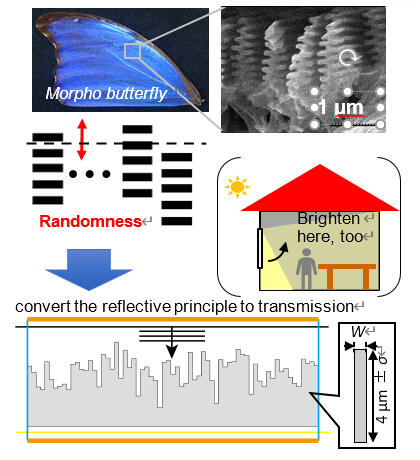Associate Professor Akira Saitou and graduate student Kazuma Yamashita, Graduate School of Engineering, Osaka City University's research group devised and designed the first bright, wide-angle, compact, color-neutral window based on a nanostructure with shining morpho butterfly wings as a model. They succeeded in proving its effectiveness through simulation. The morpho butterfly is a blue shining butterfly from South America; it is called a 'living jewel'. The color of its wings is seemingly inconsistent in physical terms, and although the wings have the same optical interference properties as soap bubbles, they are not rainbow-colored, but wide-angle and blue. The secret lies in the messy nanostructures that form the wings.
According to Associate Professor Saitou, "We have long searched to apply the unique reflective characteristics of the Morpho butterflies (high brilliance, wide-angular range, not iridescent = only blue despite the interference) to material engineering. We have recently come up with the idea of "converting reflection to transmission."
The first problem was how to establish a reliable simulation method. The first problem was how to establish a reliable simulation method. Next was how to convert the reflective principles of the Morpho butterfly to transmission, that is, wide angular range due to diffraction spread, to prevent the rainbow color due to randomness, high transmittance due to local diffraction on the surface. The last problem was how to put the properties into concrete nano-shape parameters.
Thus far, the light passing through a window followed a straight line, and additional lighting was necessary to illuminate the room widely. However, the room became dark when scattering occurred, and it appeared rainbow-colored when the light path was bent toward the ceiling. Another issue was that the required equipment became too large when improving these dark conditions.

Credit: Osaka University
Therefore, the research group worked on spreading the light to a wide angle via diffraction (a phenomenon where a wave, when it hits a small structure similar in size to its wavelength, spreads and propagates from the incident point) from a narrow width and designed an ideal daylighting window, while precluding color bias due to clutter. High transmittance was also achieved because diffraction occurs only on the surface. Furthermore, electromagnetic field simulations that can accurately manage complex structures proved that this complex structure satisfies certain characteristics (the angle spread is ± 45° in the vertical direction, the transmittance is approximately 90%, and there is no color dispersion). Associate Professor Saitou said, "Now that we have proved the characteristics, the next step is a demonstration experiment. Beyond that, there are a wide range of applications such as architecture and lighting. In particular, Japan lags behind overseas in biomimetics in architecture, and I would like to contribute to this field. In addition, our device diffuses light brightly and widely and does not color, so I am attracted to the development of lighting."
This article has been translated by JST with permission from The Science News Ltd.(https://sci-news.co.jp/). Unauthorized reproduction of the article and photographs is prohibited.




